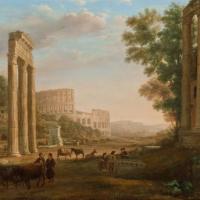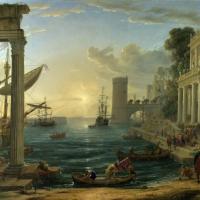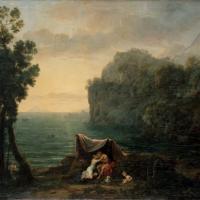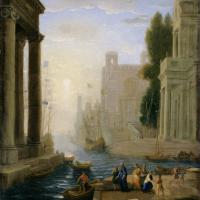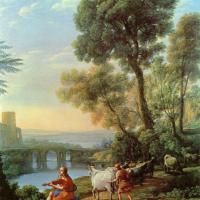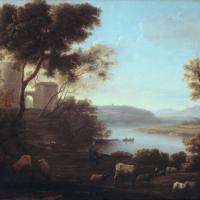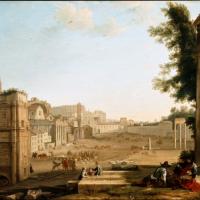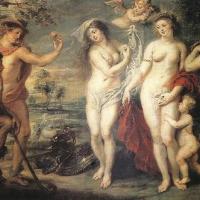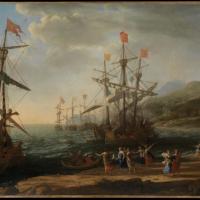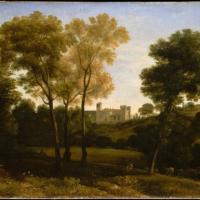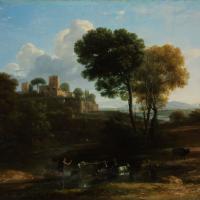Claude Loraine (1600-1682)
Claude Lorrain ( born Claude Gellée [ʒəle], called le Lorrain in French; traditionally just Claude in English; 1600 – 23 November 1682) was a French painter, draughtsman and etcher of the Baroque era. He spent most of his life in Italy, and is one of the earliest important artists, apart from his contemporaries in Dutch Golden Age painting, to concentrate on landscape painting. His landscapes are usually turned into the more prestigious genre of history paintings by the addition of a few small figures, typically representing a scene from the Bible or classical mythology.
By the end of the 1630s he was established as the leading landscapist in Italy, and enjoyed large fees for his work. These gradually became larger, but with fewer figures, more carefully painted, and produced at a lower rate. He was not generally an innovator in landscape painting, except in introducing the sun into many paintings, which had been rare before. He is now thought of as a French painter, but was born in the independent Duchy of Lorraine, and almost all his painting was done in Italy; before the late 19th century he was regarded as a painter of the "Roman School". His patrons were also mostly Italian, but after his death he became very popular with English collectors, and the UK retains a high proportion of his works.
He was a prolific creator of drawings in pen and very often monochrome watercolour "wash", usually brown but sometimes grey. Chalk is sometimes used for under-drawing, and white highlighting in various media may be employed, much less often other colours such as pink. These fall into three fairly distinct groups. Firstly there are large numbers of sketches, mostly of landscapes, and apparently very often done at the scene; these have been greatly admired, and influenced other artists. Then there are studies for paintings, of various degrees of finish, many clearly done before or during the process of painting, but others perhaps after that was complete. This was certainly the case for the last group, the 195 drawings recording finished paintings collected in his Liber Veritatis (now in the British Museum). He produced over 40 etchings, often simplified versions of paintings, mainly before 1642. These served various purposes for him, but are now regarded as much less important than his drawings. He painted frescoes in his early career, which played an important part in making his reputation, but are now nearly all lost.
As seen in his painting The Embarkation of the Queen of Sheba, Claude was innovative in including the sun itself as a source of light in his paintings.
In Rome, Bril, Girolamo Muziano and Federico Zuccaro and later Elsheimer, Annibale Carracciand Domenichino made landscape vistas pre-eminent in some of their drawings and paintings (as well as Da Vinci in his private drawings or Baldassarre Peruzzi in his decorative frescoes of vedute); but it might be argued that not until Claude's generation, did landscape completely reflect an aesthetic viewpoint which was seen as completely autonomous in its moral purpose within the cultural world of Rome.
In this matter of the importance of landscape, Claude was prescient. Living in a pre-Romantic era, he did not depict those uninhabited panoramas that were to be esteemed in later centuries, such as with Salvatore Rosa. He painted a pastoral world of fields and valleys not distant from castles and towns. If the ocean horizon is represented, it is from the setting of a busy port. Perhaps to feed the public need for paintings with noble themes, his pictures include demigods, heroes and saints, even though his abundant drawings and sketchbooks prove that he was more interested in scenography.
Claude Lorrain was described as kind to his pupils and hard-working; keenly observant, but an unlettered man until his death.
John Constable described Claude as "the most perfect landscape painter the world ever saw", and declared that in Claude's landscape "all is lovely – all amiable – all is amenity and repose; the calm sunshine of the heart".
The Claude glass, named after Lorrain in England although there is no indication he used or knew of it or anything similar, gave a framed and dark-tinted reflection of a real view, that was supposed to help artists produce works of art similar to his, and tourists to adjust views to a Claudian formula. William Gilpin, the inventor of the picturesque ideal, advocated the use of a Claude glass saying, "they give the object of nature a soft, mellow tinge like the colouring of that Master."
Claude glasses were widely used by tourists and amateur artists, who quickly became the targets of satire. Hugh Sykes Daviesobserved their facing away from the object they wished to paint, commenting, "It is very typical of their attitude to Nature that such a position should be desirable."


